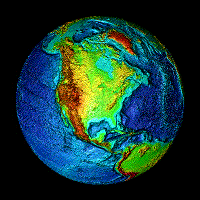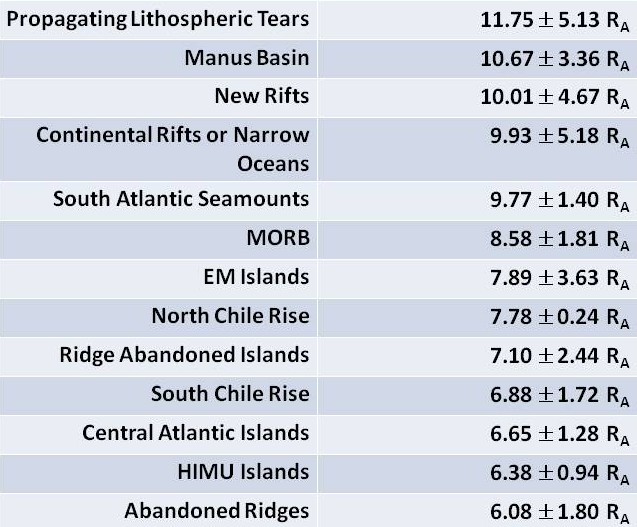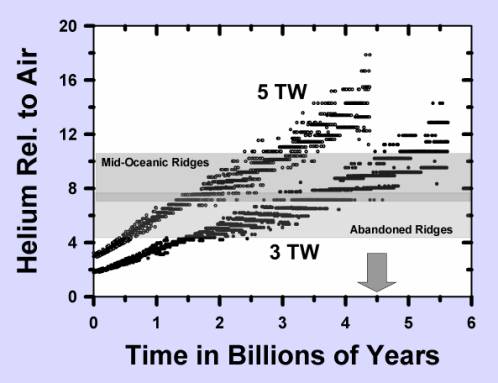

Georeactor Source of Deep-Earth Helium
 
Georeactor Source of Deep-Earth Helium |
Since the late 1960s, scientists throughout the world have found traces of helium in volcanic basalt that comes from within the Earth. For decades, the origin of that helium was (wrongly) postulated with ad hoc assumptions. Then, J. Marvin Herndon's concept of a nuclear fission georeactor at the center of Earth came along [1-12] and the deep-Earth helium measurements provided strong confirmatory evidence.
 Two isotopes of
deep-Earth helium are observed,
helium of mass 3 and helium of mass 4. Helium-4 was not a surprise because
helium-4 is a product of the
natural radioactive decay of uranium and thorium.
Helium-3, however, was a great mystery as scientists were unaware of any
deep-Earth natural
mechanism for major production of helium-3.
Two isotopes of
deep-Earth helium are observed,
helium of mass 3 and helium of mass 4. Helium-4 was not a surprise because
helium-4 is a product of the
natural radioactive decay of uranium and thorium.
Helium-3, however, was a great mystery as scientists were unaware of any
deep-Earth natural
mechanism for major production of helium-3.
Lacking knowledge of an adequate deep-Earth production mechanism, scientists, for more than thirty years, have assumed that the observed helium-3 is a relic left over from planetary formation 4.5 billion years ago. To explain the helium found in volcanic basalt, scientists have also had to assume that about 9 times as much helium-4 from radioactive decay had to have been mixed with the assumed primordial helium-3 in such a way as to give a rather narrow range of compositions, shown statistically for 95% confidence in table at right.
The table at right does not reveal the whole picture. Helium observed in basalt from deep-source "hotspots" can have significantly higher values. High He-3/He-4 ratios, some as high as 37 relative to air, are observed in Hawaiian and Icelandic basalts. Generally, most hotspot helium values, relative to air, are ≥10.
The (false) assumption that the source of deep-Earth helium-3 was trapped primordial helium led to a plethora of "mantle mixing" models.

But then came the georeactor numerical simulations. The figure at left shows more precise helium fission product data for two numerical simulations, published in 2003 by J. Marvin Herndon in the Proceedings of the National Academy of Sciences USA [7]. for comparison, two bands are shown representing the ranges of helium ratios for mid-oceanic ridges and abandoned oceanic ridges. The arrow shown points to the present age of the Earth. TW stands for million-megawatts, the unit of georeactor power.
Note the upward trend in the helium isotope ratios with the passage of time. The increase in the He-3/He-4 ratio is a consequence of the decrease in helium-4 from radioactive decay as the uranium fuel is consumed by nuclear fission. High He-3/He-4 ratios, some as high as 37 relative to air, are observed in Hawaiian and Icelandic basalts. These high ratios are an indication that the end of the georeactor's life is approaching, which means as well the end of the geomagnetic field, but the time frame is unknown [7].
The helium coming out of the Earth is strong evidence for the georeactor's existence. See reference [14] to download an excellent description of the helium problem solved. Ultimately, other evidence for georeactor existence may arise, such as seismic evidence and antineutrino evidence. At present, resolution of earthquake waves is not sufficient to reveal the georeactor. Detecting antineutrinos from georeactor fission products holds potential, but technological advances are necessary. Antineutrino measurements to date have not refuted the existence of the georeactor [13].
Ultimately, other evidence for georeactor existence may arise, such as seismic evidence and antineutrino evidence. At present, resolution of earthquake waves is not sufficient to reveal the georeactor. Detecting antineutrinos from georeactor fission products holds potential, but technological advances are necessary as well as advances in truthful scientific reporting.
| References | |
| 1. |
Herndon, J. M., Nuclear fission reactors as energy sources for the giant outer planets. Naturwissenschaften, 1992, 79, 7-14. |
| 2. | Herndon, J. M., Feasibility of a nuclear fission reactor at the center of the Earth as the energy source for the geomagnetic field. Journal of Geomagnetism and Geoelectricity, 1993, 45, 423-437. (click here for pdf) |
| 3. | Herndon, J. M., Planetary and protostellar nuclear fission: Implications for planetary change, stellar ignition and dark matter. Proceedings of the Royal Society of London, 1994, A455, 453-461. (click here for pdf) |
| 4. | Herndon, J. M., Sub-structure of the inner core of the Earth. Proceedings of the National Academy of Sciences USA, 1996, 93, 646-648. (click here for pdf) |
| 5. | Herndon, J. M., Examining the overlooked implications of natural nuclear reactors. Eos, Transactions of the American Geophysical Union, 79, 451, 456. (click here for pdf) |
| 6. | Hollenbach, D. F. and Herndon, J. M., Deep-Earth reactor: Nuclear fission, helium, and the geomagnetic field. Proceedings of the National Academy of Sciences USA, 2001, 98, 11085-11090. (click here for pdf) |
| 7. |
Herndon, J. M., Nuclear georeactor origin of oceanic basalt 3He/4He, evidence, and implications. Proceedings of the National Academy of Sciences USA, 2003, 100, 3047-3050. (click here for pdf) |
| 8. | Herndon, J. M., Nuclear georeactor generation of the Earth's geomagnetic field. Current Science, 2007, 93, 1485-1487. (click here for pdf) |
| 9. | Herndon, J. M., Maverick's Earth and Universe. 2008, Vancouver: Trafford Publishing. ISBN 978-1-4251-4132-5. |
| 10. | Herndon, J. M., Nature of planetary matter and magnetic field generation in the Solar System. Current Science, 2009, 96, 1033-1039. (click here for pdf) |
| 11. | Herndon, J. M., Uniqueness of Herndon's georeactor: Energy source and production mechanism for Earth's magnetic field. arXiv:0901.4509 28 Jan 2009. (click here for pdf) |
| 12. | Herndon, J. M., Origin of the Geomagnetic Field: Consequence of Earth's Early Formation as a Jupiter-Like Gas Giant: Thinker Media, Inc., 2012, ISBN: 978-1-938240-91-1. |
| 13. | Gando, A., et al., Partial radiogenic heat model for Earth revealed by geoneutrino measurements. Nature Geoscience, 2011, 4, 647-651. |
| 14. | Rao, K, R., Nuclear reactor at the core of the Earth! – A solution to the riddles of relative abundances of helium isotopes and geomagnetic field variability. Current Science, 2002, 82, 126-127. (click here for pdf) |